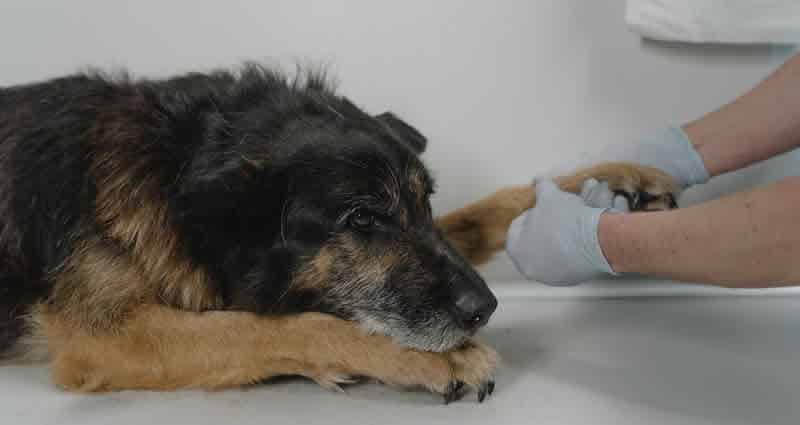Understanding how you can tell if your dog is sick is a valuable tool that all dog owners should know.
When your dog is not feeling well it’s important as a dog owner to be able to recognize when things are not right. Being in a position to tell when your dog is sick will give you information that the veterinarian needs to treat your dog successfully.
We have looked at ways to assess your dog’s wellness by showing how to check for the following:
Dehydration | Shock | Normal Pulse
In this article, we are looking at how you can tell if your dog is sick by covering 4 main areas of concern.
1. Understand what is normal for your Dog (Baseline of Wellness)
2. Check your Dog’s BAR
3. Emergency Rule Out
4. Conduct a Wellness Check

1. Understand What Is Normal For Your Dog (Baseline of Wellness)
The first tip would be to understand what is ‘normal’ for your unique dog. You cannot know what is abnormal for your dog if you do not understand what ‘normal’ looks like for him. You need a ‘baseline of wellness’. During your activities of daily living with your dog, try to notice and remember his eating, sleeping, exercise, and drinking habits. Watch and remember his breathing, facial expressions, how he holds his body when he sits and walks. Also, note his urination and defecation habits. All of these observations are your dog’s ‘baseline of wellness”. Your dog’s ‘normal’.
Knowing your dog’s Baseline of Wellness will assist you in determining if your dog is sick. If any of the observations on your Baseline of Wellness are inconsistent on any given day, you should ask yourself, “Is my dog getting sick”. Let’s use your dog’s poop habits as an example to illustrate how you can tell if your dog is sick. Let’s say your dog has explosive diarrhea one morning on his walk. This is the observation on your Baseline of Wellness.
.
2. Check your Dog’s BAR
Your first step in trying to determine if your dog is sick would be to check your dog’s BAR, as the Veterinarians call it. This acronym simply means that your dog is Bright, Alert, and Responsive in spite of this one symptom. If the dog has a normal BAR, you can deduce that he is feeling alright. It could have just been a dietary intolerance but you will want to monitor this symptom as it could change.
.
3. Emergency Rule Out
If your dog does not have a normal BAR; perhaps he is lying around and looking a bit lethargic, you would want to Rule out an Emergency. Your “emergency rule out” uses the three tools to assess your dog’s wellness that was already discussed, which are checking for Dehydration, Shock, and Normal Pulse.
If all of these assessments are normal, it would appear that there is no emergency but your dog still has an Abnormal BAR so more investigation is needed.
If your dog has an abnormal bar but you have ruled out an emergency by checking for dehydration shock and a normal pulse.
.
4. Conduct A Wellness Check
The next step would be to do a Wellness Check. A wellness check is a head-to-toe layman’s examination of your dog for his general health. It should take five minutes. The areas you should examine and what you should be looking for are as follows:
Eyes
They should be clean clear and bright. Bad signs would be red, filmy, cloudy, inflamed eyes, green or yellow discharge, dry eyes. Other signs that your dog may have an eye problem would be if he is rubbing his eyes, squinting, or tearing
Ears
They should be clean, pink, cool to the touch. Bad signs would be discharge, red, inflamed, scabbed ears. Other signs your dog may have an ear problem would be if he scratches his ears, shakes his head or if the ears have a foul odor or a waxy leathery feel.
Nose
It should be moist with no cuts, cracks, or discharge. Bad signs would be congested, cracked, or dry.
Mouth and Teeth
It should be clean with unbroken white teeth, pink gums, no smell with a good capillary refill time, and a normal swallowing pattern.
Breathing
It should be regular, clear, normal. Bad signs would be irregular, rapid, shallow, labored, breathing. Sneezing, coughing, lungs sounding moist, open mouth to breathe
Skin and Hair
It should have no foul odor, no flaky skin. Bad signs would be lumps scabs, ticks, fleas, wounds, hair loss, bald spots, red skin, irritated skin, or hot spots
Legs and Feet
They should present no limping, short nails, pads with no split broad areas bruises mats, or growths. Paws should be free of cuts scrapes matted hair or spots. Bad signs would be your dog favoring one leg or having limited motion.
Anal Area
Your dog should have a normal stool and anal glands that are not impacted. Bad signs would be scratching or anal area on the ground. Watery or bloody stool, diarrhea, or constipation.
General Observations
Your dog should be bright, alert, responsive and his skin should be elastic meaning it springs back immediately after being raised showing he is hydrated. Bad signs would be head tilting, circling repeatedly, bloated abdomen and he appears disoriented with either a rapid or a slow pulse.
If the wellness check showed no problems, then you should monitor the symptom just in case it was diarrhea and you should re-evaluate the next time your dog is supposed to defecate.
If the wellness check shows a problem such as the dog’s eyes are not bright, rather have a lethargic look and the abdomen looks a little bloated and is grumbling when you touch it then this would indicate that your dog is feeling sick. We know it’s not a medical emergency at this point because we have already performed the emergency rule out. Unfortunately, dogs cannot speak to us so we do not know the extent of how poorly the dog is feeling. At this point, you could either research how to treat your dog for this condition or you can continue to monitor the conditions in the event it resolves itself. Those choices are a topic for a different discussion.
.
Summary Review
In order to determine if your pet is sick, check your dog’s BAR, then do your emergency rule out, and finally, do a wellness check.
You should conduct a wellness check on a weekly basis in order to know your dog’s Baseline of Wellness. If you know what your dog’s eyes, ears, nose, mouth, breathing, skin and hair, legs and feet, anal area, and general appearance look like normally, only then will you be able to tell what is abnormal for your particular dog.
For Further Information
For a complete, encyclopedic survival guide to all aspects of dog health, from preventative care to choosing a vet to doggie First Aid (even the canine Heimlich maneuver!), you should take a look at The Ultimate Guide to Dog Health.
It’s a survival guide for knowledgeable, effective, and life-saving dog care. This manual keeps your dog’s health and well-being firmly within your control – which is exactly where you want it to be.







